Abstract
With the deteriorating environment and excessive consumption of primary energy, solar energy has become used in buildings worldwide for renewable energy. Due to the fluctuations of solar radiation, a solar photovoltaic (PV) power system is often combined with a storage battery to improve the stability of a building’s energy supply. In addition, the real-time energy consumption pattern of the residual houses fluctuates; a larger size for a PV and battery integrated system can offer more solar energy but also bring a higher equipment cost, and a smaller size for the integrated system may achieve an energy-saving effect. The traditional methods to size a PV and battery integrated system for a detached house are based on the experience method or the traversal algorithm. However, the experience method cannot consider the real-time fluctuating energy demand of a detached house, and the traversal algorithm costs too much computation time. Therefore, this study applies Nondominated Sorting Genetic Algorithm-II (NSGA-II) to size a PV and battery integrated system by optimizing total electricity cost and usage of the grid electricity simultaneously. By setting these two indicators as objectives separately, single-objective genetic algorithms (GAs) are also deployed to find the optimal size specifications of the PV and battery integrated system. The optimal solutions from NSGA-II and single-objective GAs are mutually verified, showing the high accuracy of NSGA-II, and the rapid convergence process demonstrates the time-saving effect of all these deployed genetic algorithms. The robustness of the deployed NSGA-II to various grid electricity prices is also tested, and similar optimal solutions are obtained. Compared with the experience method, the final optimal solution from NSGA-II saves 68.3% of total electricity cost with slightly more grid electricity used. Compared with the traversal algorithm, NSGA-II saves 94% of the computation time and provides more accurate size specifications for the PV and battery integrated system. This study suggests that NSGA-II is suitable for sizing a PV and battery integrated system for a detached house.
1. Introduction
With the development of society, the global demand for energy is increasing rapidly [1]. The increasing consumption of primary energy can bring a series of environmental problems, such as air pollution, global warming, and resource depletion [2]. Some studies have suggested that 40% of global energy consumption and 50% of global greenhouse gas emissions are related to buildings [3]. Therefore, expanding the use of renewable energy in buildings is of great significance in addressing the environmental crisis, and many governments have adopted ambitious policies [4,5,6]. With solid policy support, the electricity from solar photovoltaic (PV) increased by a record 179 TWh and exceeded 1000 TWh total in 2021 worldwide, demonstrating that solar PV generation has become the largest source of renewable energy after wind [7]. Many private sectors are investing in distributed solar PV, and the rooftop solar PV percentage of total installed PV capacity is over 32% [8]. With the continuous progress of technology, the cost of PV has decreased rapidly, which will further promote the application of solar PV in buildings all over the world [9].
Solar PV is generally integrated with a storage battery to improve the stability of the energy utilization of the solar PV generation system [10]. Figure 1 shows the electricity demand and solar PV generation of a detached house on one winter day. Because solar radiation is an uncontrollable environmental factor, the real-time electricity generation from solar PV is unstable. The real-time electricity demand of a house also varies with its functions and environmental changes. Hence, a solar PV and battery integrated system can be deployed to mitigate the above fluctuations. The batteries can store the electricity when electricity from solar PV is greater than the electricity demand from the house, and provide electricity when electricity demand cannot be satisfied from solar PV.
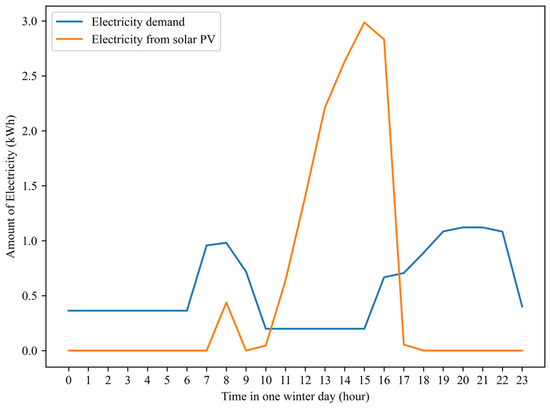
Figure 1.
An example diagram of electricity demand and solar PV generation of a detached house.
To decrease the equipment cost of the PV and battery integrated system and increase its environmental benefits, the proper size of the PV and the capacity of storage batteries should be customized based on the real-time electricity load of buildings. The experience methods directly use the average daily electricity load to estimate the size of storage batteries and solar PV [11], which can cause a waste of resources. There are many optimization studies for sizing renewable energy systems based on the economic and environmental effects. Kaabeche and Ibtiouen [12] used an iterative technique to optimize an integrated solar PV, wind turbines, diesel generator, and battery system with a given capacity for the battery and varying numbers of PV panels and wind turbines. Ssheb-Koussa et al. [13] optimized the size of a hybrid renewable energy system for four various sites in Algeria using MATLAB/Simulink (version 7.14) using a deterministic approach. Based on the weekly power dispatch simulation, Zhang et al. [14] employed linear programming to optimize integrated PV, diesel generator, and storage battery systems. Ekren, O. and Ekren, B.Y. [15] used the response surface method to compute the optimal PV area, rotor swept area of a wind turbine, and battery capacity in which the data for one-hour electricity load from 15 random days in each season were used. Akram et al. normalized the daily average electricity load in Dammam and used an iterative search algorithm to optimize the sizes of the PV, wind turbine, and battery materials [16]. With four estimated hours of electricity consumption, Ahmadj and Abdi minimized the total present cost of a hybrid renewable energy system by using a Hybrid Big Bang–Big Crunch algorithm [17]. Singh et al. optimized the net present value cost of a hybrid energy system to obtain the best solution for a PV size and power storage device [18].
Most of the above studies only applied averaged daily or monthly electricity loads and considered one objective when sizing the hybrid renewable system. However, in some areas, the real electricity demand may fluctuate significantly with environmental changes. Additionally, for complex systems with multiple objectives, linear programming, iterative techniques, nonlinear programming, and other classical optimization techniques are not suitable anymore [19]. Genetic algorithms can find the global optimal in a relatively short computation time because of their inherent capacity to randomly search for the optimal in all directions. Through selection, crossover, and mutation operators, genetic algorithms can enhance the quality of a population in every generation [20]. Nondominated Sorting Genetic Algorithm-II (NSGA-II) is a variant of a genetic algorithm that can better preserve good solutions during iterations of GA simulations [21]. Many studies have demonstrated that genetic algorithms and their variants, especially NSGA-II, can solve the complex optimization problems for hybrid renewable energy systems [19,22,23]. Chang et al. applied a one-year hourly electricity demand to a detached house and developed a model of a PV and battery integrated system [24]. The optimal size specifications of the integrated system were much better than the solutions from the experience method, but the deployed traversal algorithm cost too much computation time. Therefore, this work utilizes a model of a PV and battery integrated system with hourly electricity load data in a year [24] and uses NSGA-II to overcome the drawbacks of the traversal algorithm.
The rest of this paper is organized as follows. First, the PV and battery integrated system is introduced, and the total electricity cost and usage of grid electricity are defined as the two indicators considering the economic and environmental benefits of the households. Second, NSGA-II is customized to optimize the above two indicators simultaneously. To verify the accuracy of NSGA-II, a single-objective genetic algorithm (GA) is deployed to optimize the above two indicators separately. The convergence process of the deployed genetic algorithms is also analyzed comprehensively, which shows the time-saving effects. The robustness of the deployed NSGA-II to various grid electricity prices is also tested. Finally, NSGA-II is compared with the traditional method to further prove the accuracy and time-saving effects of NSGA-II in sizing a PV and battery integrated system.
2. Methodology
With the certain size specifications of a PV and battery integrated system, including the area of PV, the installation angle of PV, and the capacity of the storage battery, the developed mathematical model of the PV and battery integrated system can be used to calculate the annual total electricity cost and the yearly usage of grid electricity of a detached house based on its one-year hourly electricity demands and related hourly solar radiation. The experience method uses yearly average daily electricity demand to determine the size specifications, while the traversal algorithm tries to find the optimal by going through all available size specifications. The deployed NSGA-II finds the best size specifications by simultaneously optimizing the total electricity cost and the usage of grid electricity. This section first introduces the developed mathematical model of the PV and battery integrated system and the traditional methods. Then, the calculation process for the deployed NSGA-II is explained, and the optimization problem to be solved in this study is defined.
2.1. PV and Battery Integrated System and the Traditional Methods
The PV and battery integrated system utilizes solar PV panels to transform solar energy to electricity. The PV-generated real-time electricity is used to satisfy the demand from the house first, and the excess electricity is stored in a battery to deal with the condition that PV-generated real-time electricity cannot meet the real-time electricity demand from the house. If both the PV-generated real-time electricity and stored electricity in the battery cannot satisfy the electricity demand from the house, the integrated system will purchase electricity from the grid. The amount of PV-generated real-time electricity can be calculated with the following [25]:
where is the conversion efficiency of the solar cell array (14.4%), is the total array area (m2), is the solar radiation on an inclined surface (kW/m2), and is the outside air temperature (°C). Lead–acid batteries are used as storage batteries due to their relatively high energy performance and low price. The detailed specifications for a lead–acid storage battery are shown in Table 1 [26].

Table 1.
Specifications of a lead–acid battery.
The responses of annual total electricity cost to the economic benefits of the householders can be used to calculate the annual total cost of the PV and battery integrated system. The definition of total electricity cost is as follows:
where represents the total annual electricity cost of the household, refers to the installation cost of the PV, where the average service life of PV is 25 years, represents the installation cost of a storage battery with an average service life of 5 years, and stands for the cost of purchasing grid electricity [27]. The used grid electricity represents environmental benefits because grid electricity generally comes from thermal plants that consume fossil energy and emit CO2. The lower usage of grid electricity means that more fossil fuels are replaced by renewable energy, catering to environmental benefits.
Figure 2 shows the mathematical model of the PV and battery integrated system, where EI_Demand represents the hourly electricity demand of the house, EI_PV is the hourly PV-generated electricity, and BT_Total refers to the remaining electricity in the storage battery. In Figure 2, the size specifications of the integrated system should be defined first. Then the file for the hourly solar radiation and hourly electricity demand of the house for one year needs to be input. The generation and consumption of the electricity are analyzed hourly with an iteration loop. If the real-time electricity demand for the house is smaller than the real-time PV generation, the excess electricity will be stored in a storage battery. When the storage battery is full, the rest of the electricity will be discharged to the ground. If the real-time electricity demand of the house is larger than the real-time PV generation, the stored electricity in the battery will be used. If the real-time electricity demand of the house is over the sum of the real-time PV generation and the remaining electricity in the battery, the system will purchase electricity from the grid. Hourly electricity usage conditions over the entire year are calculated and recorded using an iteration loop. When the iteration is finished, the annual total electricity cost and yearly grid electricity used are obtained.
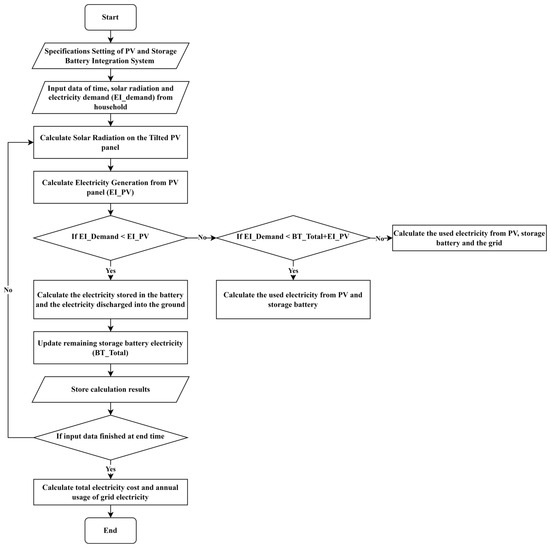
Figure 2.
Flowchart for the mathematical model of PV and battery integrated system.
The traditional methods to size the PV and battery integrated system for a detached house include the experience method and the traversal algorithm. This work studies a PV and battery integrated system that is deployed in a detached house in Zhouzhi County, Xian, China [24]. The detached house is located in the northwestern region of China. The experience method considers the total area of the south roof of the house as the area of PV, which is determined to be 62 m2. The capacity of the storage battery can also be set based on the following experience [11]:
where is the capacity of the storage battery, is the average daily electricity load of the detached house, and is the discharge depth of the storage battery. The capacity of the storage battery utilized here is set to 56 kWh by the experience equation. The installation angle is obtained from a reference, which is 26 °C for the research area [27]. The traversal algorithm is generally set to try all potential solutions. In this study, the available ranges of the area of PV, installation angle of PV, and the capacity of the storage battery are included in Table 2, as well as other specifications shown for the PV and battery integrated system relating to the economic cost. The traversal algorithm sample for these specification ranges with an interval of one.

Table 2.
Specifications of the PV and battery integrated system.
2.2. The Optimization Process of the NSGA-II
The area of PV, the installation angle of PV, and the capacity of a storage battery of the PV and battery integrated system are considered the design variables in this study. Considering other economic factors shown in Table 1 and Table 2, as well as the hourly weather data extracted from the ASHRAE code [28], the annual total electricity cost and yearly used grid electricity can be calculated using the mathematical model illustrated in Figure 2. The optimization goal is to minimize the annual total electricity cost and maximize yearly used grid electricity simultaneously. Hence, the mathematical expression for the optimization problem can be defined as
NSGA-II is one of the most popular multiobjective optimization algorithms and it can converge to a good spread of solutions near the Pareto optimal front. This work used the Python package Pymoo (version 0.6.1) to deploy NSGA-II to find three optimal size specifications of the integrated system (the area of PV, the installation angle of PV, and the capacity of the storage battery) [29]. The model of the PV and battery integrated system was used as the evaluation function to calculate the total electricity cost and usage of the grid electricity. A float random sampling method was used to create the initial population with a size of 100 individuals, and the size of offspring was set to 30. Simulated binary crossover (SBX) and polynomial mutations (PMs) operators were used with a crossover probability of 0.7 and a mutation probability of 0.9 [30]. The detailed calculation process is shown in Figure 3. First, the NSGA-II parameters had to be initialized, and the constraint ranges of the size specifications of the PV and battery integrated system had to be determined. Then the initial population was created, in which the randomly sampled size specifications were encoded into the genes of the N individuals in the initial population. Next, the mathematical mode of the integrated system was used as the fitness function to calculate the total electricity cost and usage of grid electricity for all individuals. With the total electricity cost and usage of grid electricity of all individuals, the population was sorted using nondominated sorting, after which the iteration was started. The first offspring population was generated through mating selection, crossover, and mutation operations. Then, the mathematical model of the PV and battery integrated system computed the total electricity cost and usage of the grid electricity of the offspring population. Next, the offspring population combined with the parent population, and fast nondominated sorting was carried out, and the crowding distance was computed. Based on the sorting and crowding distance, a new generation population could be created by choosing N individuals from the combination of the parent population and offspring population. Finally, the iteration criteria for whether the maximum iteration generation was achieved were checked. If the iteration criteria were not satisfied, the iteration loop continued, and if the criteria were satisfied, the obtained optimal solutions were output.
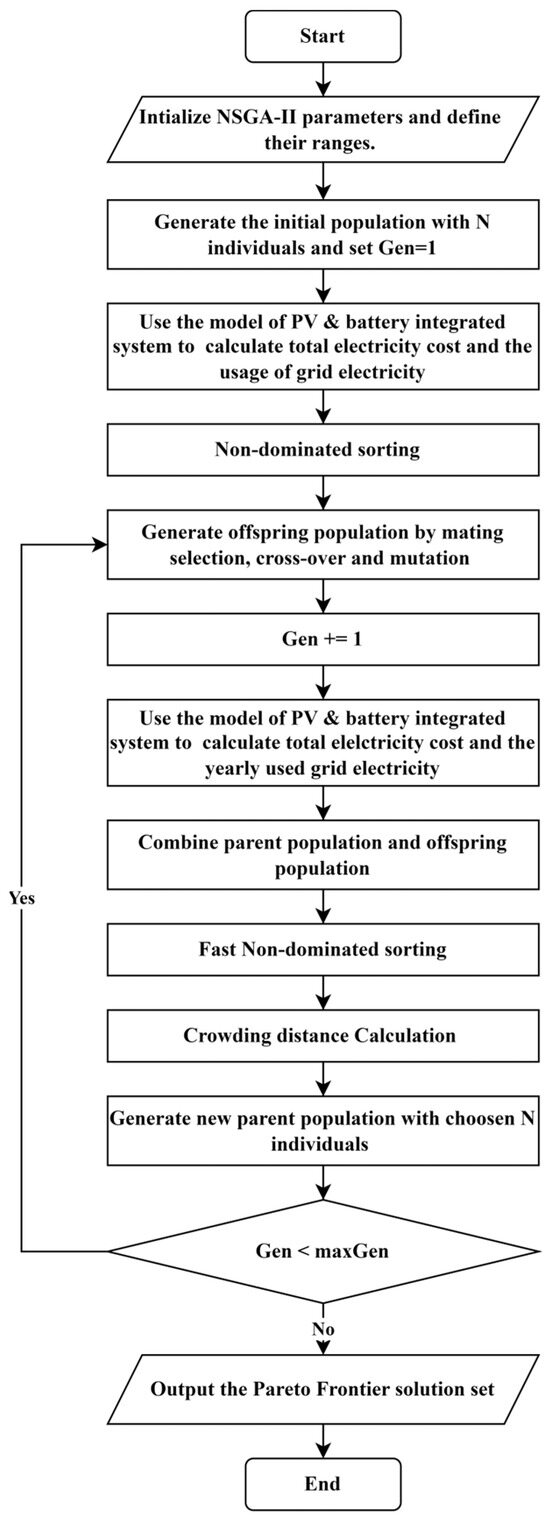
Figure 3.
The deployed NSGA-II with the model of PV and battery integrated system.
The Pareto front approach considers the varying importance of the various objectives simultaneously and offers insights about trade-offs between the alternative choices [31,32]. The deployed NSGA-II utilized the Pareto front approach to derive the optimal solution set. The true Pareto front was unknown, and NSGA-II and other evolutionary algorithms could only generate its approximation with the iteration of the generation. The hypervolume was the performance indicator of the derived Pareto front optimal solution, and it was based on the volume between the solution provided and the predefined reference point. The value of the reference point had to be greater than the maximum value of the Pareto front. As discussed in Section 3, the hypervolume was used to analyze the convergence of NSGA-II.
3. Results
NSGA-II was used to optimize the total electricity cost and usage of electricity of the PV and battery integrated system simultaneously, and a single-objective GA was used to optimize the above two indicators separately. Figure 3 and Figure 4 illustrate the mutually confirmed solution space and optimization results. The convergence processes of these algorithms were also considered from the perspective of computation time. Figure 5 shows the convergence processes of the genetic algorithms, and Figure 6 compares their computation time with the traversal algorithm. The robustness of the deployed algorithms to the fluctuation of grid price was also tested. Various grid prices were applied as shown in Figure 7, and the stable performances of the genetic algorithms were demonstrated.
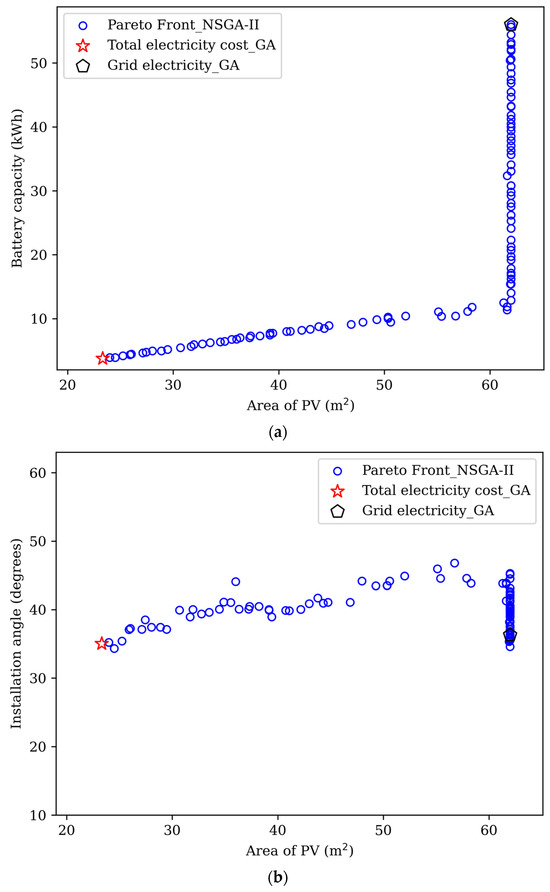
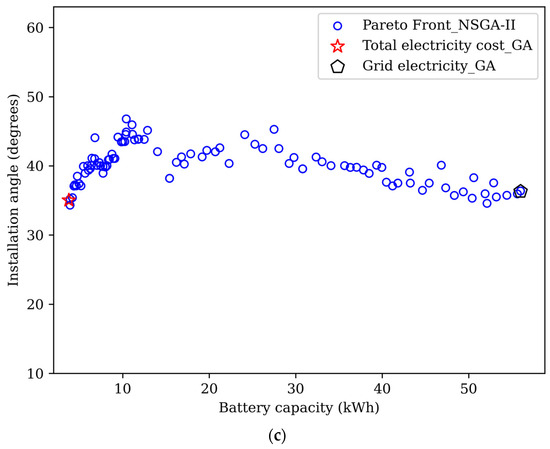
Figure 4.
Visualization of optimal solutions obtained from NSGA-II and the two single-objective GAs. (a) Area of PV vs. Battery capacity, (b) Area of PV vs. Installation angle, (c) Battery capacity vs. Installation angle.
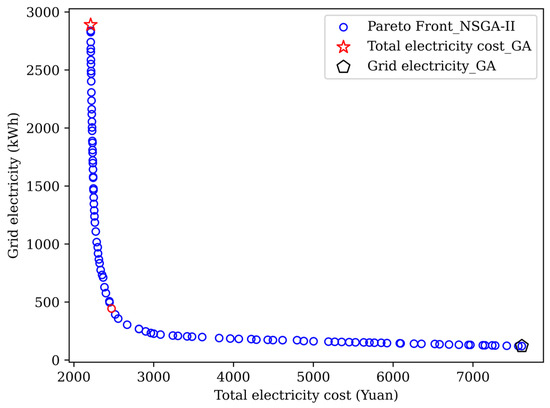
Figure 5.
Simulation results for the optimal solutions of NSGA-II and the two single-objective GAs.
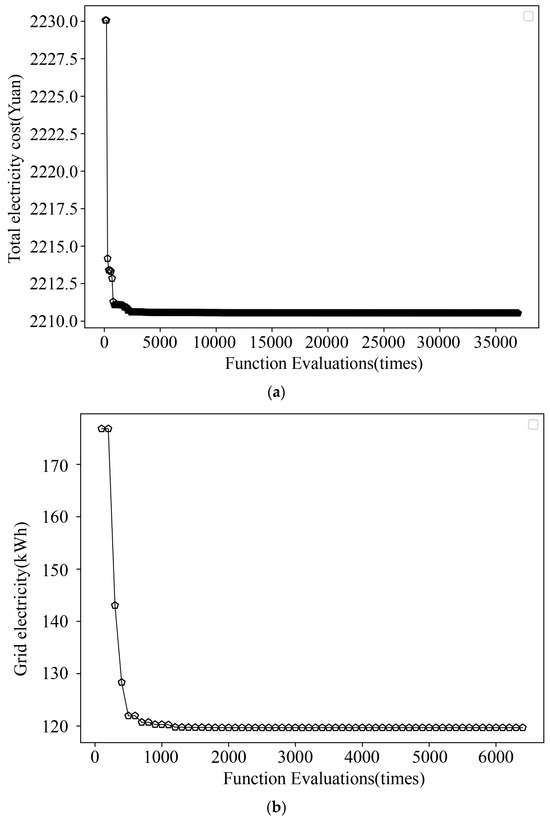
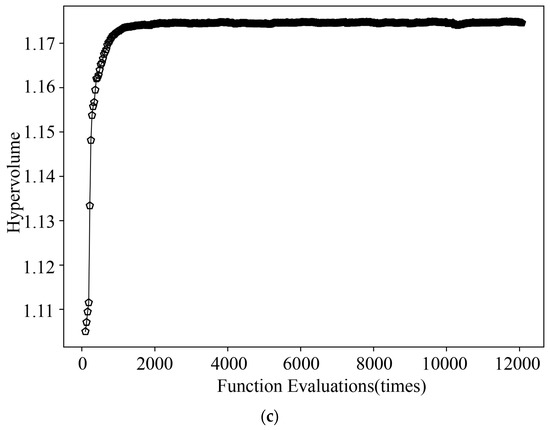
Figure 6.
Convergence processes of three genetic algorithms: (a) Single-objective GA for total electricity cost; (b) single-objective GA for the usage of grid electricity; (c) NSGA-II.
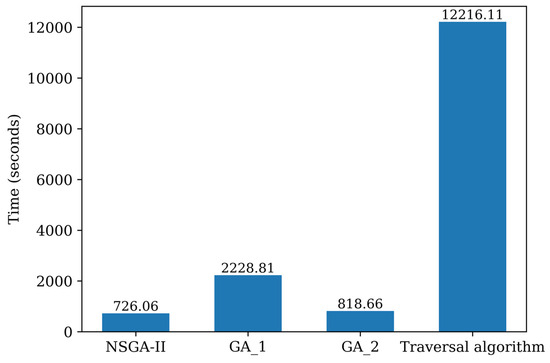
Figure 7.
Running time of the four algorithms on an Intel i7-12700 CPU. GA_1 represents the single-objective GA for total electricity cost, and GA_2 represents the single-objective GA for the usage of grid electricity.
Figure 4 shows the optimal solutions of the deployed genetic algorithms. In Figure 4, the blue circles represent the Pareto front solutions of the NSGA-II. The red five-pointed star represents the optimal solution of the single-objective GA for the total electricity cost and the black pentagon represents the optimal solution of the single-objective GA for the usage of grid electricity. The installation angle of the PV in the Pareto front solutions varied from 35 to 47°, which was significantly smaller than the initial installation angle range. The areas of PV in the Pareto front solutions varied from 23 to 62 m2 and the capacity of the storage battery varied from 3 to 55 kWh. Both of the ranges almost coincided with the initial settled range, which demonstrated the ideal spread distribution of the Pareto front solutions for these two specifications. The optimal installation angle of PV for the two single-objective GAs was near 36°. In contrast, the optimal area of PV and the optimal capacity of the storage battery for the single-objective GAs was the opposite of this and was located at the two ends of the Pareto front solution. The simulation results for the optimal solutions of NSGA-II and the two single-objective GAs are shown in Figure 4 with abbreviations similar to those in Figure 3. The simulation results for the optimal solutions of NSGA-II and the two single-objective GAs are shown in Figure 5 with the legend labels similar to those in Figure 4. The simulation results for the two single-objective GAs are also located at the two ends of the simulation results of NSGA-II, and the distribution of the total electricity cost and the usage of grid electricity from the Pareto front solutions are continuous and spread. When the total electricity cost is less than CNY 3000, the used grid electricity greatly decreases from 2800 to 246 kWh. Then the grid electricity used slowly decreases to 119.7 kWh, while the total electricity cost rapidly increases to CNY 7612. In all simulation results for NSGA-II, the red circle shown in Figure 5 is chosen as the optimal solution considering the trade-off between economic and environmental benefits.
Figure 6 demonstrates the convergence process of the three genetic algorithms used. The two single-objective GAs for total electricity cost and the yearly grid electricity used obtain the stable optimal solutions after approximately 2500 and 1300 evaluations, respectively. NSGA-II achieves the Pareto front solutions with a stable hypervolume after 2000 evaluations. The running time for the above three genetic algorithms and the traversal algorithm are shown in Figure 7, where the total running times of the three genetic algorithms fluctuated for various maximum generation numbers, but all of them were significantly less than the running time of the traversal algorithm.
To test the robustness of the deployed NSGA-II to the fluctuating grid prices, five types of grid prices are utilized in Figure 8. The colored circles represent the simulation results from the Pareto front solutions of NSGA-II. The five-pointed star and pentagon represent the optimal simulation results from two GAs for various grid prices. When the grid prices vary from CNY 0.40 to 0.56/kWh, the optimal simulation results for the two GAs are still located at the two ends of the optimal simulation results of NSGA-II. The optimal simulation results for the GA for the yearly grid electricity used stay in similar positions, while the optimal simulation results of the GA for the total electricity cost and the optimal simulation results for NSGA-II with the low total electricity costs shift to the right and decrease gradually.
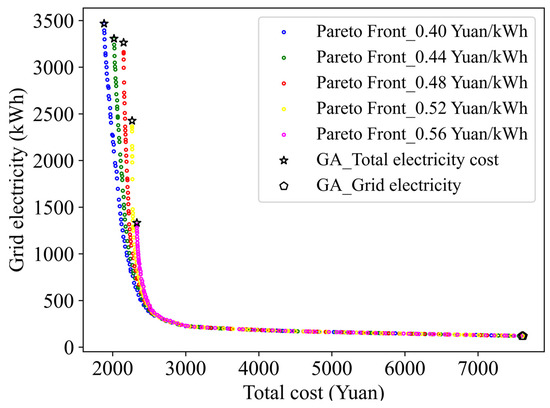
Figure 8.
Sensitivity analysis for grid prices.
4. Discussion
The optimization results for the two single-objective GAs and the optimization results of NSGA-II are mutually verified. As shown in Figure 5, the optimal solution for the two single-objective GAs, corresponding to the total electricity cost and the yearly used grid electricity, coincide with the two ends of the Pareto front solutions drawn by NSGA-II. All of the genetic algorithms utilize the random evolution process to iterate the population generation. However, for the same objective, the GA and NSGA-II converge to the same solution, demonstrating their reliability. An inherent contradiction between the two objectives can be found in Figure 4, in which the optimal area of PV and the optimal battery capacity in two GAs are totally different while the optimal installation angles of all genetic algorithms have similar values. The optimal installation angles of the PV in the Pareto front solutions vary in a small range (35–47°), and the optimal installation angles of the PV in the two GAs are near 36°, which suggests that a uniform optimal installation angle of PV exists, causing a lower total electricity cost and a lower usage of grid electricity. However, for the relatively expensive solar PV and storage battery as well as the cheap grid electricity, the use of more grid electricity and the installation of less solar PV and a smaller battery leads to a lower total electricity cost. Additionally, the lower usage of grid electricity, which is considered to bring more environmental benefits, encourages households to use more solar PV and a larger storage battery. The spread distribution of the Pareto front solutions in the area of PV and battery capacity shows the trade-off of NSGA-II for these two conflicting objectives, which is consistent with the simulation results shown in Figure 5. The users can choose proper photovoltaic and storage battery system parameters according to their interest in economic and environmental benefits. Additionally, all deployed genetic algorithms converge properly and show strong robustness with the fluctuation of the grid price in Figure 8, which further verifies the accuracy of the algorithms.
Figure 9 compares the optimal solutions from three genetic algorithms and the experience method. For the area of PV, NSGA-II and the GA for grid electricity choose large values that are similar to that of the experience method, but the GA for total electricity cost uses only a 23.3 m2 solar PV area, which is near the low bound of the area of PV. NSGA-II and the GA for total electricity cost use a much smaller battery compared to the GA for grid electricity and the experience method. The optimal installation angles of the two GAs are similar and close to 36°, which is slightly lower than that of NSGA-II (43.9°) and higher than that of the experience method (26°). In all, the optimal solution of the experience method is similar to the optimal solution of the GA for lower usage of grid electricity, which shows its trend to use more solar energy.
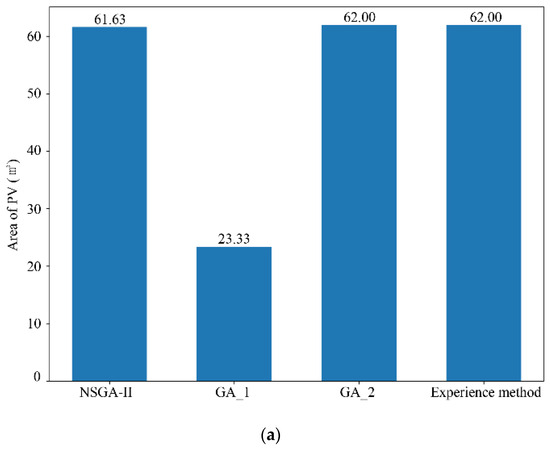
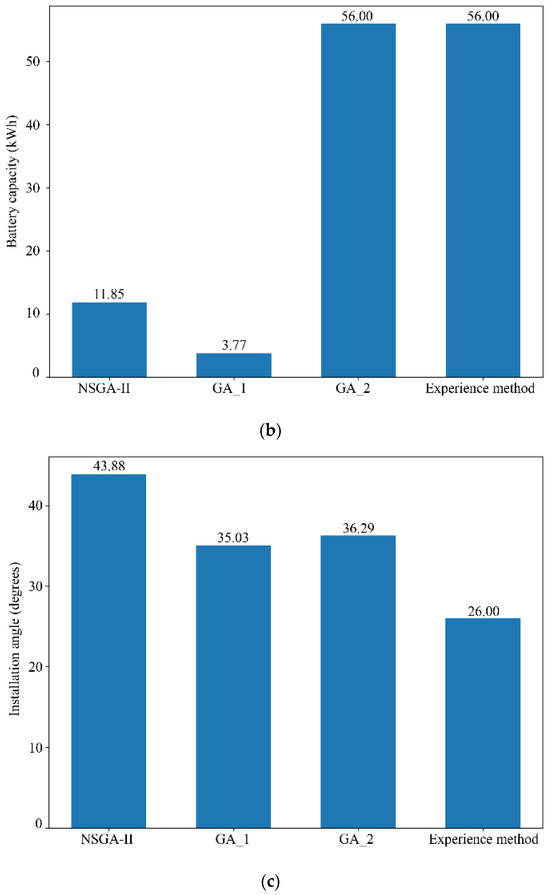
Figure 9.
A comparison of the optimal solutions obtained from the experience method and three genetic algorithms. (a) Suggested areas of PV, (b) Suggested battery capacity and (c) Suggested installation angle of PV offered by four methods are illustrated. GA_1 represents the single-objective GA for total electricity cost, and GA_2 represents the single-objective GA for usage of grid electricity.
Compared to the experience method, which utilizes the average daily electricity demand of a detached house and the approximated installation angle and area of PV according to experience, our proposed mathematical model of a PV and battery integrated system with the NSGA-II considers hourly electricity demands and related hourly solar radiation and can offer more efficient solutions. The total electricity cost of the experience method is CNY 7640, and the used grid electricity is 173.5 kWh. For the chosen optimal solution of NSGA-II, the total electricity cost is CNY 2472.1, and the grid electricity used is 443.3 kWh. Compared to the experience method, 67.6% of the total electricity cost is saved, but an additional 269.8 kWh of grid electricity is used. Based on the simulation results of NSGA-II shown in Figure 5, when the grid electricity used is 170.9 kWh, the total electricity cost is only CNY 4615.2, which means that 39.6% of the total electricity cost is saved; and when the total electricity cost is CNY 7612.8, only 119.7 kWh of grid electricity is used, which means approximately 31% of the grid electricity is saved.
All three deployed genetic algorithms cost much less computational time than the traversal algorithm. As shown in Figure 6, all of the genetic algorithms obtain stable optimal solutions after around 2000 evaluations. Figure 7 compares the specific running time of the three genetic algorithms with the traversal algorithm. In this case, even if the solutions provided by the traversal algorithm are only accurate to the integer level, 116,100 evaluations are needed. The gap in the number of evaluations highlights the time-saving characteristics of the genetic algorithms. The sampling interval of the traversal algorithm can be limited by the curse of dimensionality, while the genetic algorithms can offer accurate optimal solutions.
Figure 10 and Figure 11 clearly illustrate the difference between the genetic algorithms and the traversal algorithms. Figure 10 shows the traversal results, in which PV_waste represents the wasted electricity for PV-generated electricity over the sum of electricity demand and the rest capacity of the storage battery. Because the optimal solutions for both total electricity cost and yearly usage of grid electricity have almost the same optimal installation angles for PV and the optimal angle does not vary with the area of PV and battery capacity, only the area of PV and the battery capacity are used as variables. As shown in Figure 10, the total electricity cost increases with the battery capacity and the area of PV. This cost is significantly smaller when the battery capacity is lower, reflecting the greater effect of the battery capacity on the total electricity cost compared to the area of PV. The used grid electricity decreases as the area of PV increases. When the battery capacity is less than 10 kWh, more grid electricity is used for the suppressed ability of the battery to store and reuse electricity. PV_waste can be zero if the areas of PV and battery capacity are chosen properly. The largest area of PV and the smallest battery capacity is the worst situation that results in the largest amount of PV_waste.
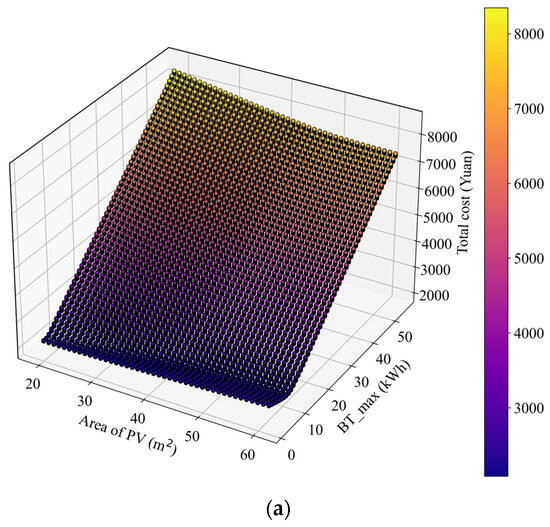
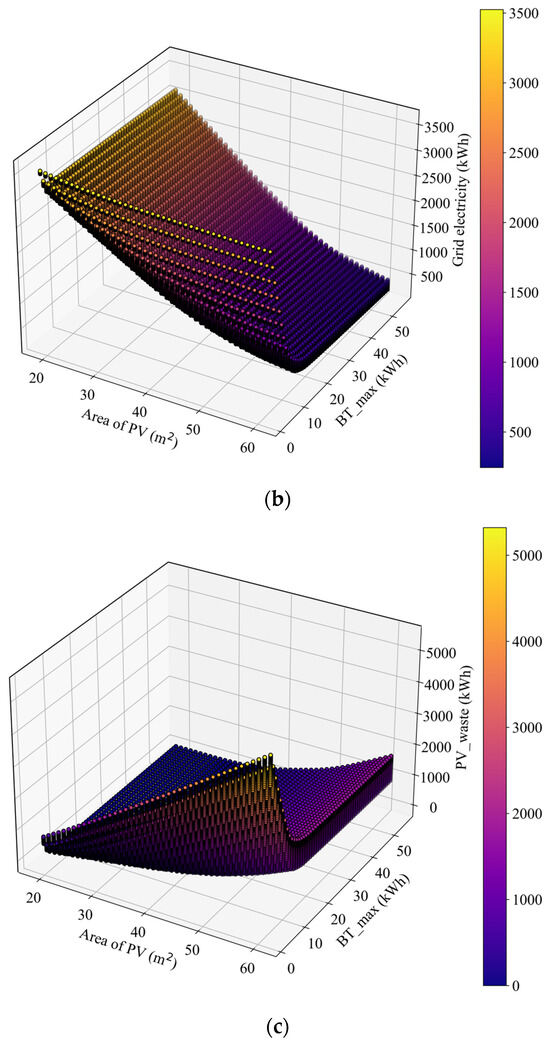
Figure 10.
Simulation results of the traversal algorithm for (a) total electricity cost, (b) usage of grid electricity, and (c) PV_waste.
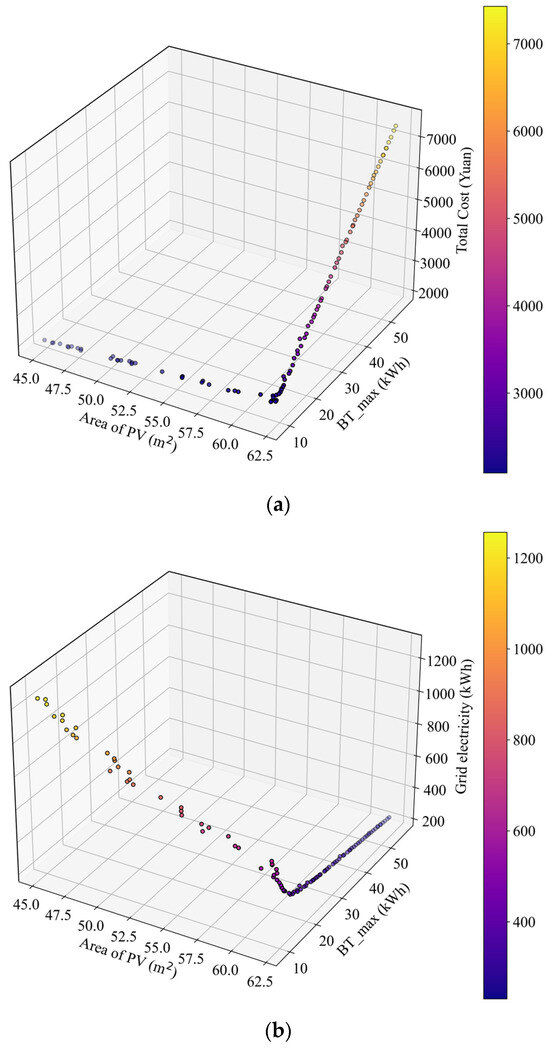
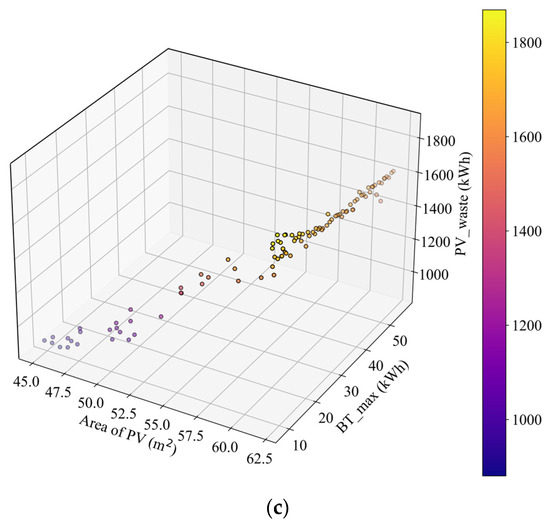
Figure 11.
NSGA-II simulation results for (a) total electricity cost, (b) usage of grid electricity, and (c) PV_waste.
Figure 11 shows the simulation results for NSGA-II, and this figure uses the same legend as Figure 10. It is clearly shown that NSGA-II requires much fewer evaluations than the traversal algorithm. As shown in Figure 11a,b, the Pareto front simulation results almost coincide with the edges of the solution space in Figure 10a,b, in which the total electricity cost and the used grid electricity have the lowest values. In Figure 11c, the largest value for PV_waste is smaller than 1600 kWh, which is much smaller than the maximum amount of PV_waste in Figure 10c, and all Pareto front solutions avoid the two extreme cases of a large area of PV with a small battery capacity or a large battery capacity with a small area of PV. Additionally, the interval of parameters for the traversal approach in Figure 10 is one, which only offers integer solutions, while NSGA-II can offer accurate decimal solutions. All of this confirms the accuracy and time-saving of the deployed NSGA-II.
5. Conclusions
The deteriorating environment and fossil fuel depletion necessitate increased renewable energy adoption, and the conflict between economic and environmental interests requires more efficient solutions. This study employs a developed mathematical model for a PV and battery integrated system for detached houses to optimize total electricity cost and yearly used grid electricity, catering to economic and environmental interests. Utilizing the model with the hourly real-time electricity demands of the house, the deployed NSGA-II algorithm can find more efficient optimal solutions than the traditional methods. The key conclusions are as follows.
- NSGA-II and the two single-objective GAs applied to the PV and battery integrated system produce consistent optimal solutions, even with fluctuating grid prices, demonstrating the accuracy of NSGA-II.
- All of the genetic algorithms converge quickly, achieving stable optimal solutions after approximately 2000 evaluations. NSGA-II completes the optimization in 726.1 s, saving 94% of the computation time compared to the traversal algorithms (12,216.1 s).
- The Pareto front solutions of NSGA-II reveal a clear trade-off between economic and environmental benefits. The experience method incurs a total electricity cost of CNY 7640 and uses 173.5 kWh of grid electricity, while the optimal NSGA-II solution costs CNY 2446.7 and uses 496.3 kWh, aligning better with typical household preferences.
- The traversal algorithm is inefficient and limited to integer solutions. NSGA-II intelligently bypasses unreasonable parameter ranges, aligning with the traversal algorithm’s solution space edges where total electricity cost and grid electricity usage are minimized.
This study provides a framework for optimizing PV and battery system sizes for detached houses, but there are some limitations. First, because this study addresses detached houses in rural areas, more cost-effective lead–acid batteries are chosen. Other types of batteries available on the market (e.g., lithium batteries) are not investigated, and there is a lack of generalizability of the analyses in this regard. In addition, the analytical data used in the study are derived from simulations, not measured data. Subsequent analysis using measured data would increase the credibility of the study’s conclusions. These limitations will continue to be addressed in future studies. Our future work will integrate more renewable energy sources into the model and test more complex application scenarios to generalize the system for various building types.
Author Contributions
Conceptualization, H.C. and Y.Y.; methodology, Y.H., Q.Y. and H.C.; investigation, X.W., D.Z., Y.D. and J.Z.; writing—original draft preparation, X.W., D.Z., Y.D. and J.Z.; supervision, H.C. and C.W.; funding acquisition, H.C. All authors have read and agreed to the published version of the manuscript.
Funding
This research was funded by the National Key R&D Program of China (grant no. 2022YFB3303200), the Key Scientific Research Projects of Colleges and Universities in Henan Province (grant no. 22B560020), and the Science and Technology Project of Henan Province of China (grant no. 232102240024).
Data Availability Statement
Data are contained within the article.
Conflicts of Interest
The authors declare no conflicts of interest.
References
- IEA. Global Energy Review 2021. 2021. Available online: https://www.iea.org/reports/global-energy-review-2021 (accessed on 1 April 2021).
- Deymi-Dashtebayaz, M.; Nikitin, A.; Davoodi, V.; Nikitina, V.; Hekmatshoar, M.; Shein, V. A New Multigenerational Solar Energy System Integrated with Near-Zero Energy Building Including Energy Storage–A Dynamic Energy, Exergy, and Economic-Environmental Analyses. Energy Convers. Manag. 2022, 261, 115653. [Google Scholar] [CrossRef]
- Pandey, S. Impact of Green Building Rating Systems on the Sustainability and Efficacy of Green Buildings: Case Analysis of Green Building Index, Malaysia; Universiti Teknologi Malaysia: Johor Bahru, Malaysia, 2018. [Google Scholar]
- Razmjoo, A.; Mirjalili, S.; Aliehyaei, M.; Østergaard, P.A.; Ahmadi, A.; Nezhad, M.M. Development of Smart Energy Systems for Communities: Technologies, Policies and Applications. Energy 2022, 248, 123540. [Google Scholar] [CrossRef]
- Zhang, X. Green Real Estate Development in China: State of Art and Prospect Agenda—A Review. Renew. Sustain. Energy Rev. 2015, 47, 1–13. [Google Scholar] [CrossRef]
- Wilberforce, T.; Olabi, A.G.; Sayed, E.T.; Elsaid, K.; Maghrabie, H.M.; Abdelkareem, M.A. A Review on Zero Energy Buildings–Pros and Cons. Energy Built Environ. 2023, 4, 25–38. [Google Scholar] [CrossRef]
- IEA. Solar PV. 2023. Available online: https://www.iea.org/energy-system/renewables/solar-pv (accessed on 9 January 2024).
- Share of Rooftop Installed Solar Panels in Total Solar Photovoltaic Deployment Worldwide from 2015 to 2020, with a Forecast until 2022. Statista 2020. Available online: https://www.statista.com/statistics/1172031/rooftop-share-in-solar-pv-deployment/ (accessed on 6 November 2020).
- Yan, J.; Yang, Y.; Elia Campana, P.; He, J. City-Level Analysis of Subsidy-Free Solar Photovoltaic Electricity Price, Profits and Grid Parity in China. Nat. Energy 2019, 4, 709–717. [Google Scholar] [CrossRef]
- Argyrou, M.C.; Marouchos, C.C.; Kalogirou, S.A.; Christodoulides, P. Modeling a Residential Grid-Connected PV System with Battery–Supercapacitor Storage: Control Design and Stability Analysis. Energy Rep. 2021, 7, 4988–5002. [Google Scholar] [CrossRef]
- Bilgili, M.; Ozbek, A.; Sahin, B.; Kahraman, A. An Overview of Renewable Electric Power Capacity and Progress in New Technologies in the World. Renew. Sustain. Energy Rev. 2015, 49, 323–334. [Google Scholar] [CrossRef]
- Kaabeche, A.; Ibtiouen, R. Techno-Economic Optimization of Hybrid Photovoltaic/Wind/Diesel/Battery Generation in a Stand-Alone Power System. Sol. Energy 2014, 103, 171–182. [Google Scholar] [CrossRef]
- Saheb-Koussa, D.; Haddadi, M.; Belhamel, M. Economic and Technical Study of a Hybrid System (Wind–Photovoltaic–Diesel) for Rural Electrification in Algeria. Appl. Energy 2009, 86, 1024–1030. [Google Scholar] [CrossRef]
- Zhang, X.; Tan, S.-C.; Li, G.; Li, J.; Feng, Z. Components Sizing of Hybrid Energy Systems via the Optimization of Power Dispatch Simulations. Energy 2013, 52, 165–172. [Google Scholar] [CrossRef]
- Ekren, O.; Ekren, B.Y. Size Optimization of a PV/Wind Hybrid Energy Conversion System with Battery Storage Using Response Surface Methodology. Appl. Energy 2008, 85, 1086–1101. [Google Scholar] [CrossRef]
- Akram, U.; Khalid, M.; Shafiq, S. Optimal Sizing of a Wind/Solar/Battery Hybrid Grid-connected Microgrid System. IET Renew. Power Gener. 2018, 12, 72–80. [Google Scholar] [CrossRef]
- Ahmadi, S.; Abdi, S. Application of the Hybrid Big Bang–Big Crunch Algorithm for Optimal Sizing of a Stand-Alone Hybrid PV/Wind/Battery System. Sol. Energy 2016, 134, 366–374. [Google Scholar] [CrossRef]
- Singh, G.; Baredar, P.; Singh, A.; Kurup, D. Optimal Sizing and Location of PV, Wind and Battery Storage for Electrification to an Island: A Case Study of Kavaratti, Lakshadweep. J. Energy Storage 2017, 12, 78–86. [Google Scholar] [CrossRef]
- Memon, S.A.; Patel, R.N. An Overview of Optimization Techniques Used for Sizing of Hybrid Renewable Energy Systems. Renew. Energy Focus 2021, 39, 1–26. [Google Scholar] [CrossRef]
- Hinton, G.E.; Van Camp, D. Keeping the Neural Networks Simple by Minimizing the Description Length of the Weights. In Proceedings of the Sixth Annual Conference on Computational Learning Theory—COLT ’93, Santa Cruz, CA, USA, 26–28 July 1993; ACM Press: Santa Cruz, CA, USA, 1993; pp. 5–13. [Google Scholar] [CrossRef]
- Deb, K.; Pratap, A.; Agarwal, S.; Meyarivan, T. A Fast and Elitist Multiobjective Genetic Algorithm: NSGA-II. IEEE Trans. Evol. Comput. 2002, 6, 182–197. [Google Scholar] [CrossRef]
- Yang, H.; Wei, Z.; Chengzhi, L. Optimal Design and Techno-Economic Analysis of a Hybrid Solar–Wind Power Generation System. Appl. Energy 2009, 86, 163–169. [Google Scholar] [CrossRef]
- Hong, Y.-Y.; Lian, R.-C. Optimal Sizing of Hybrid Wind/PV/Diesel Generation in a Stand-Alone Power System Using Markov-Based Genetic Algorithm. IEEE Trans. Power Deliv. 2012, 27, 640–647. [Google Scholar] [CrossRef]
- Chang, H.; Jing, F.-L.; Hou, Y.-L.; Chen, L.-Q.; Yang, Y.-J.; Liu, T.-Y.; Wei, C.-L.; Zhai, B.-Q.; Hou, C.-Y. Development of a Mathematical Model to Size the Photovoltaic and Storage Battery Based on the Energy Demand Pattern of the House. Front. Energy Res. 2022, 10, 945180. [Google Scholar] [CrossRef]
- Yoza, A.; Yona, A.; Senjyu, T.; Funabashi, T. Optimal Capacity and Expansion Planning Methodology of PV and Battery in Smart House. Renew. Energy 2014, 69, 25–33. [Google Scholar] [CrossRef]
- Chen, W. Applying Research of Storage Batteries in Photovoltaic System. Chin. Labat Man 2006, 43, 21. [Google Scholar]
- Layadi, T.M.; Champenois, G.; Mostefai, M.; Abbes, D. Lifetime estimation tool of lead–acid batteries for hybrid power sources design. Simul. Model. Pract. Theory 2015, 54, 36–48. [Google Scholar] [CrossRef]
- Energy Efficient Design for Low-Rise Residential Buildings. ASHRAE 2020, 90, 2.
- Blank, J.; Deb, K. Pymoo: Multi-Objective Optimization in Python. IEEE Access 2020, 8, 89497–89509. [Google Scholar] [CrossRef]
- Deb, K.; Sindhya, K.; Okabe, T. Self-Adaptive Simulated Binary Crossover for Real-Parameter Optimization. In Proceedings of the 9th Annual Conference on Genetic and Evolutionary Computation, London, UK, 7–11 July 2007; ACM: London, UK, 2007; pp. 1187–1194. [Google Scholar] [CrossRef]
- Cao, Y.; Smucker, B.J.; Robinson, T.J. On Using the Hypervolume Indicator to Compare Pareto Fronts: Applications to Multi-Criteria Optimal Experimental Design. J. Stat. Plan. Inference 2015, 160, 60–74. [Google Scholar] [CrossRef]
- Lu, L.; Anderson-Cook, C.M.; Robinson, T.J. Optimization of Designed Experiments Based on Multiple Criteria Utilizing a Pareto Frontier. Technometrics 2011, 53, 353–365. [Google Scholar] [CrossRef]
Disclaimer/Publisher’s Note: The statements, opinions and data contained in all publications are solely those of the individual author(s) and contributor(s) and not of MDPI and/or the editor(s). MDPI and/or the editor(s) disclaim responsibility for any injury to people or property resulting from any ideas, methods, instructions or products referred to in the content. |
© 2024 by the authors. Licensee MDPI, Basel, Switzerland. This article is an open access article distributed under the terms and conditions of the Creative Commons Attribution (CC BY) license (https://creativecommons.org/licenses/by/4.0/).